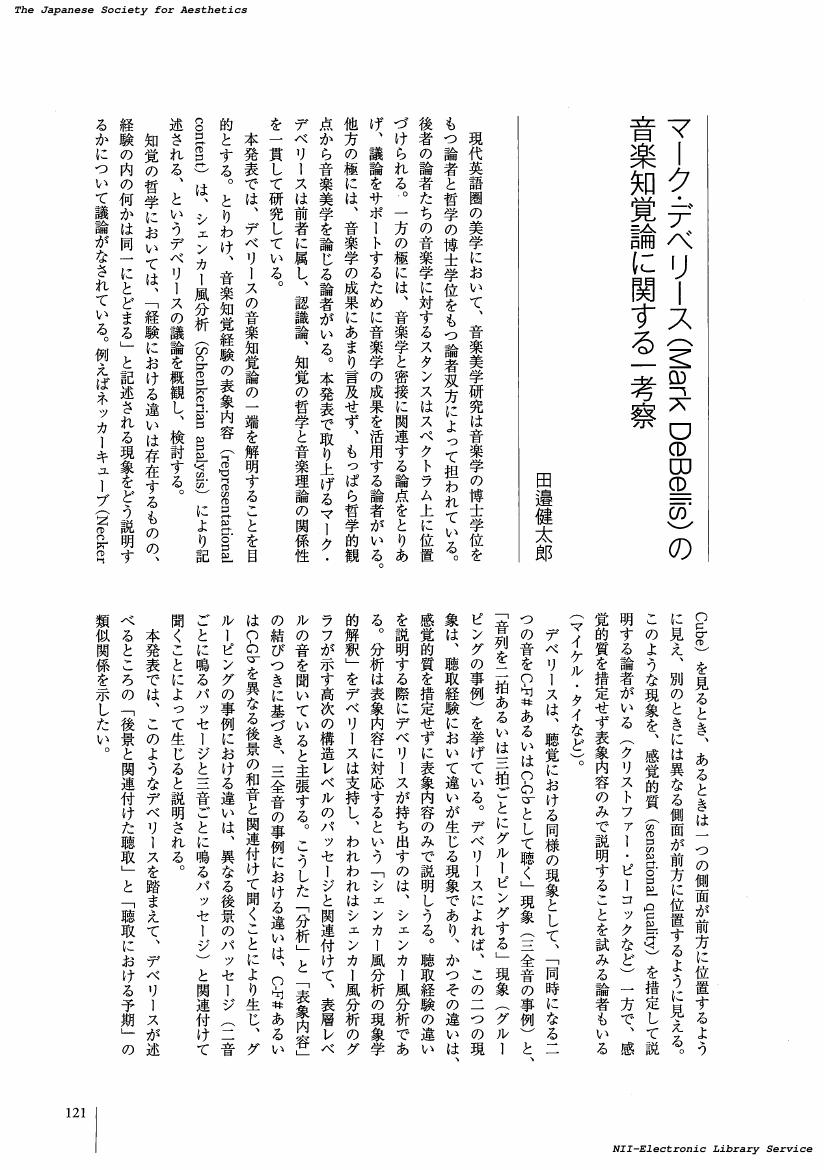- 著者
- 田邉 健太郎
- 出版者
- 美学会
- 雑誌
- 美学 (ISSN:05200962)
- 巻号頁・発行日
- vol.64, no.1, pp.71-82, 2013
Jerrold Levinson insists that musical works are indicated type entities. The aim of this paper is, first, to summarize and clarify his view and, second, to examine his view and the criticisms which are directed towards Levinson's notions of "indication" and "creating type." In Section 1, I summarize why Levinson rejects "Sound Structure Theory." His motivations for rejecting it are two. First, he assumes musical works can be created, but sound structure cannot. Second, he assumes musical works must be individuated so finely that they can bear the aesthetic/artistic properties which we ordinarily attribute to them. In Section 2, I explain his proposal that musical works are indicated type entities and "Indicated Type Theory" avoids the problems which "Sound Structure Theory" cannot. In Section 3, I examine two criticisms of Levinson's view. The first criticism concerns the ontological nature of indicated type. But I think Levinson can object to that criticism. The second criticism concerns his notion of "creating new type." This is a genuine problem for Levinson.
2 0 0 0 IR ジュリアン・ドッドの音楽作品の存在論を再検討する -聴取可能性の問題を中心に
- 著者
- 田邉 健太郎
- 出版者
- 立命館大学大学院先端総合学術研究科
- 雑誌
- Core Ethics : コア・エシックス = Core Ethics : コア・エシックス (ISSN:18800467)
- 巻号頁・発行日
- no.8, pp.267-278, 2012
- 著者
- 田邉 健太郎
- 出版者
- 美学会
- 雑誌
- 美学 (ISSN:05200962)
- 巻号頁・発行日
- vol.64, no.1, pp.71-82, 2013-06-30 (Released:2017-05-22)
Jerrold Levinson insists that musical works are indicated type entities. The aim of this paper is, first, to summarize and clarify his view and, second, to examine his view and the criticisms which are directed towards Levinson's notions of "indication" and "creating type." In Section 1, I summarize why Levinson rejects "Sound Structure Theory." His motivations for rejecting it are two. First, he assumes musical works can be created, but sound structure cannot. Second, he assumes musical works must be individuated so finely that they can bear the aesthetic/artistic properties which we ordinarily attribute to them. In Section 2, I explain his proposal that musical works are indicated type entities and "Indicated Type Theory" avoids the problems which "Sound Structure Theory" cannot. In Section 3, I examine two criticisms of Levinson's view. The first criticism concerns the ontological nature of indicated type. But I think Levinson can object to that criticism. The second criticism concerns his notion of "creating new type." This is a genuine problem for Levinson.
1 0 0 0 OA 条件付き連鎖主義の意義と課題 ジェロルド・レヴィンソン『瞬間の中の音楽』の批判的検討
- 著者
- 田邉 健太郎
- 出版者
- 美学会
- 雑誌
- 美学 (ISSN:05200962)
- 巻号頁・発行日
- vol.68, no.2, pp.138, 2017 (Released:2019-01-02)
- 著者
- 田邉 健太郎
- 出版者
- 美学会
- 雑誌
- 美学 (ISSN:05200962)
- 巻号頁・発行日
- vol.65, no.2, pp.121, 2014-12-31 (Released:2017-05-22)
- 著者
- 田邉 健太郎
- 出版者
- 美学会
- 雑誌
- 美学 (ISSN:05200962)
- 巻号頁・発行日
- vol.63, no.2, pp.134, 2012-12-31 (Released:2017-05-22)
- 著者
- 田邉 健太郎
- 出版者
- 美学会
- 雑誌
- 美学 (ISSN:05200962)
- 巻号頁・発行日
- vol.62, no.2, pp.121, 2011-12-31 (Released:2017-05-22)



